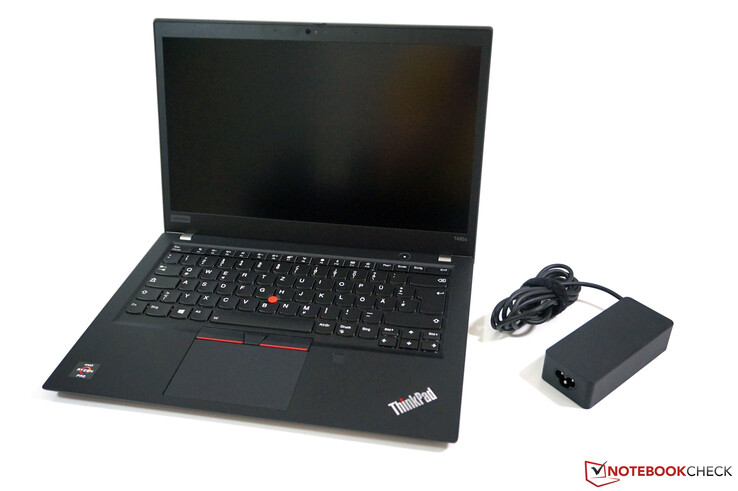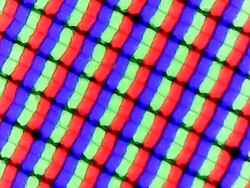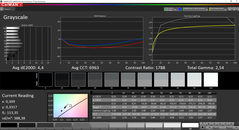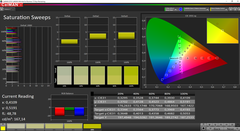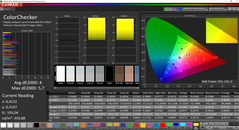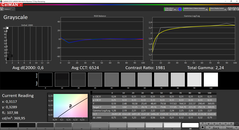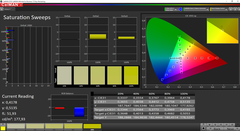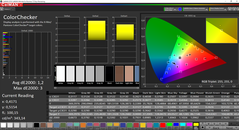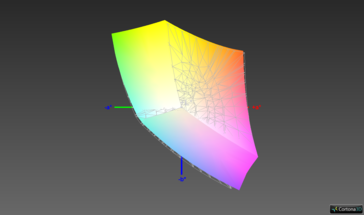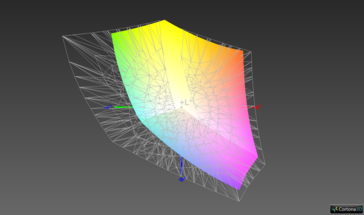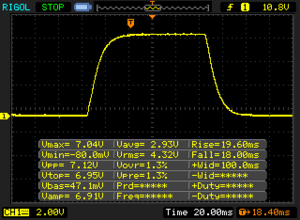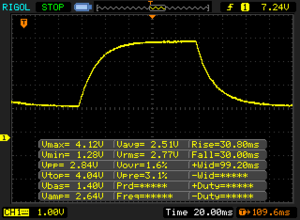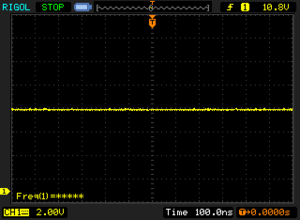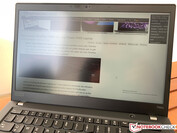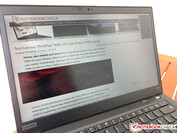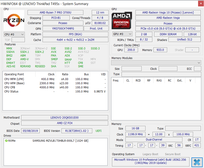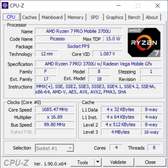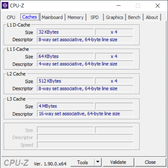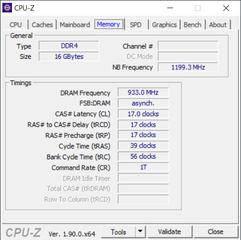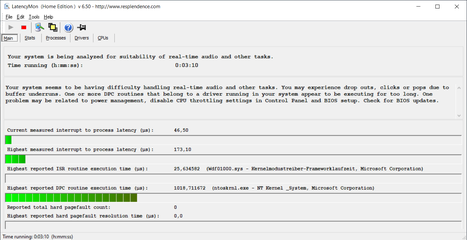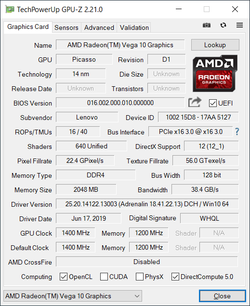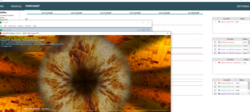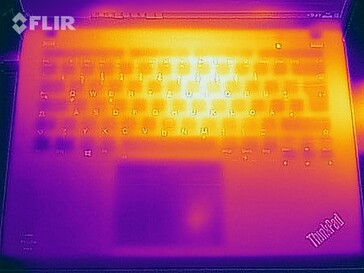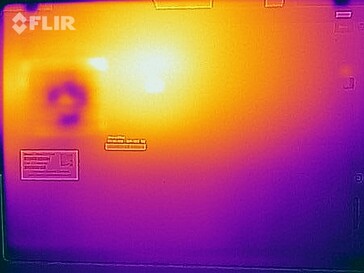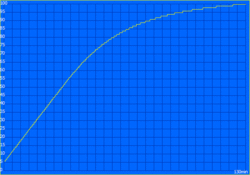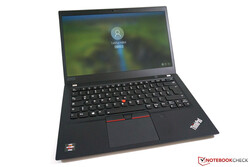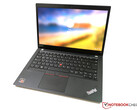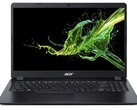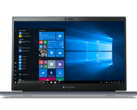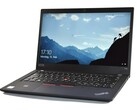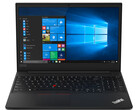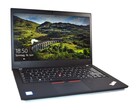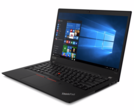Lenovo ThinkPad T495s Review: The AMD business laptop is good, but the fan is annoying

We have already looked at the ThinkPad T490s with the Intel processor in detail and found it a great office notebook. On the other hand, Lenovo has also made some compromises with the new design, since the performance turns out lower compared to the direct predecessor. The slimmer case does not offer a dedicated GPU anymore, and the CPU performance is also lower. In this regard, now there is also the ThinkPad T495s based on AMD, which uses the identical case. With the Ryzen 7 Pro and its integrated Vega 10 GPU, there is significantly more graphics power than in the corresponding Intel model.
Another argument for the T495s is its low price, since with a comparable equipment, you save about 300 Euros (~$330) compared to the T490s. Our test unit (20QKS01E00) comes from the Campus program and with the Ryzen 7 Pro 3700U, 16 GB of RAM, a 1-TB SSD, and the bright Full HD panel (400 nits), it costs only just 1299 Euros (~$1429; without operating system). The corresponding model with Windows 10 Pro is available in Lenovo's online shop for about 1850 Euros (~$2035; $1635 in the US); and the corresponding T490s, for 2330 Euros (~$2562). We will of course compare the ThinkPad T495s with the ThinkPad T490s, but also with the T495 and the X1 Carbon 2019:
- Test Lenovo ThinkPad T490s
- Test Lenovo ThinkPad T495
- Test Lenovo ThinkPad X1 Carbon 2019 (WQHD)
- Test Lenovo ThinkPad X1 Carbon 2019 (FHD)
Note that since the case does not differ from that of the ThinkPad T490s, for details on its construction, connection equipment, input devices, and speakers, we refer you to our detailed review of the Intel model.
Differences between the ThinkPad T495s and T490s
As already mentioned in the comparison between the ThinkPad T490 and T495, there are no external differences between the two models. So other than looking at the stickers on the base unit, you cannot see whether it is a ThinkPad with an Intel or an AMD processor. However, Lenovo offers more display options for the Intel model, while the maximum resolution you can get for the ThinkPad T495s is Full HD. The AMD ThinkPad also does not offer Thunderbolt 3, but instead, there are HDMI 2.0 and a display with FreeSync support (adaptive synchronization technology). Due to the rather low gaming performance and the limited frequencies of the display (48-60 Hz), the functionality of FreeSync is limited.
| SD Card Reader | |
| average JPG Copy Test (av. of 3 runs) | |
| Lenovo ThinkPad T495s-20QKS01E00 (Toshiba Exceria Pro M501 64 GB UHS-II) | |
| Lenovo ThinkPad T495-20NKS01Y00 (Toshiba Exceria Pro M501 64 GB UHS-II) | |
| Lenovo ThinkPad T480s-20L8S02E00 (Toshiba Exceria Pro SDXC 64 GB UHS-II) | |
| Lenovo ThinkPad T490s-20NYS02A00 (Toshiba Exceria Pro M501) | |
| Average of class Office (22.4 - 198.5, n=29, last 2 years) | |
| maximum AS SSD Seq Read Test (1GB) | |
| Lenovo ThinkPad T495-20NKS01Y00 (Toshiba Exceria Pro M501 64 GB UHS-II) | |
| Lenovo ThinkPad T495s-20QKS01E00 (Toshiba Exceria Pro M501 64 GB UHS-II) | |
| Lenovo ThinkPad T490s-20NYS02A00 (Toshiba Exceria Pro M501) | |
| Lenovo ThinkPad T480s-20L8S02E00 (Toshiba Exceria Pro SDXC 64 GB UHS-II) | |
| Average of class Office (25 - 249, n=27, last 2 years) | |
Display – The ThinkPad T495s with a bright FHD display
The built-in 1080p panel with an advertised brightness of 400 nits is the highest display option for the ThinkPad T495s. The options with a higher resolution are reserved for the T490s Intel model. However, since the quality of the Full-HD display is completely okay and the resolution is sufficient for many application scenarios in our opinion, this limitation should not become a problem for most users.
On the other hand, it is a problem that Lenovo gets these 400-nit panels from four different manufacturers and they do show some differences. The most important here are the response times, which turn out to be very slow in two of the models, producing some streaking effects. This is also the case with the panel from AU Optronics (B140HAN05.7) that is used here. You can find out about all the other details on the four panel variants here. Unfortunately, there is no way to know ahead of time, which model you will get.
Subjectively, the display quality of the T495s is still able to convince, since the brightness as well as the contrast are high, and the content display is sharp. Despite the matte surface, there is no grainy image impression. Screen-bleeding is not a problem, and PWM is also not used.
| |||||||||||||||||||||||||
Brightness Distribution: 87 %
Center on Battery: 380 cd/m²
Contrast: 1727:1 (Black: 0.22 cd/m²)
ΔE ColorChecker Calman: 4 | ∀{0.5-29.43 Ø4.77}
calibrated: 1.2
ΔE Greyscale Calman: 4.4 | ∀{0.09-98 Ø5}
96.6% sRGB (Argyll 1.6.3 3D)
62.2% AdobeRGB 1998 (Argyll 1.6.3 3D)
68.3% AdobeRGB 1998 (Argyll 3D)
96.8% sRGB (Argyll 3D)
67% Display P3 (Argyll 3D)
Gamma: 2.54
CCT: 6963 K
| Lenovo ThinkPad T495s-20QKS01E00 B140HAN05.7, , 1920x1080, 14" | Lenovo ThinkPad T495-20NKS01Y00 N140HCG-GQ2, , 1920x1080, 14" | Lenovo ThinkPad T490s-20NYS02A00 B140HAN05.7, , 1920x1080, 14" | Lenovo ThinkPad T490-20N3S02L00 NE140FHM-N61, , 1920x1080, 14" | Lenovo ThinkPad X1 Carbon 2019-20QES01L00 LP140WF9_SPF1, , 1920x1080, 14" | |
|---|---|---|---|---|---|
| Display | 1% | 0% | -1% | -3% | |
| Display P3 Coverage (%) | 67 | 67 0% | 67.1 0% | 69.3 3% | 64.5 -4% |
| sRGB Coverage (%) | 96.8 | 98.5 2% | 97.6 1% | 92.2 -5% | 95.8 -1% |
| AdobeRGB 1998 Coverage (%) | 68.3 | 69.2 1% | 68.5 0% | 67.4 -1% | 65.7 -4% |
| Response Times | 54% | -2% | -22% | 27% | |
| Response Time Grey 50% / Grey 80% * (ms) | 60.8 ? | 32.4 ? 47% | 61.6 ? -1% | 74 ? -22% | 44.8 ? 26% |
| Response Time Black / White * (ms) | 37.6 ? | 15.2 ? 60% | 38.8 ? -3% | 45.6 ? -21% | 27.6 ? 27% |
| PWM Frequency (Hz) | 26040 ? | 2451 ? | |||
| Screen | 8% | 4% | -16% | -9% | |
| Brightness middle (cd/m²) | 380 | 420 11% | 391 3% | 418 10% | 381 0% |
| Brightness (cd/m²) | 381 | 391 3% | 389 2% | 400 5% | 375 -2% |
| Brightness Distribution (%) | 87 | 88 1% | 87 0% | 88 1% | 94 8% |
| Black Level * (cd/m²) | 0.22 | 0.29 -32% | 0.23 -5% | 0.24 -9% | 0.24 -9% |
| Contrast (:1) | 1727 | 1448 -16% | 1700 -2% | 1742 1% | 1588 -8% |
| Colorchecker dE 2000 * | 4 | 2.1 47% | 3.4 15% | 4.7 -18% | 4.6 -15% |
| Colorchecker dE 2000 max. * | 5.7 | 5.5 4% | 4.7 18% | 8.7 -53% | 8.5 -49% |
| Colorchecker dE 2000 calibrated * | 1.2 | 0.7 42% | 1.1 8% | 2.1 -75% | 1.2 -0% |
| Greyscale dE 2000 * | 4.4 | 3.4 23% | 4 9% | 5.9 -34% | 5.1 -16% |
| Gamma | 2.54 87% | 2.22 99% | 2.49 88% | 2.06 107% | 2.52 87% |
| CCT | 6963 93% | 7168 91% | 6809 95% | 7350 88% | 7052 92% |
| Color Space (Percent of AdobeRGB 1998) (%) | 62.2 | 63.5 2% | 62.4 0% | 59.9 -4% | 60.7 -2% |
| Color Space (Percent of sRGB) (%) | 96.6 | 98.6 2% | 97.4 1% | 92.1 -5% | 95.7 -1% |
| Total Average (Program / Settings) | 21% /
12% | 1% /
3% | -13% /
-14% | 5% /
-3% |
* ... smaller is better
The new LowPower Full HD panel in the 14-inch ThinkPads offers a very high image quality, which is also confirmed by the CalMAN measurements. Although there are still some deviations in the colors and grayscale in the state of delivery, there is no visible tint, and the display does not need to be calibrated for regular office work.
In order to be able to use the display to its full potential, you need to calibrate it. You can download our free calibration profile for the AUO panel using the link in the display box above. Using this, the deviations for the grayscale and also the colors drop below the important value of 3. So in combination with the almost complete coverage of the sRGB color space, image processing will also be possible.
Display Response Times
| ↔ Response Time Black to White | ||
|---|---|---|
| 37.6 ms ... rise ↗ and fall ↘ combined | ↗ 19.6 ms rise | |
| ↘ 18 ms fall | ||
| The screen shows slow response rates in our tests and will be unsatisfactory for gamers. In comparison, all tested devices range from 0.1 (minimum) to 240 (maximum) ms. » 95 % of all devices are better. This means that the measured response time is worse than the average of all tested devices (20.2 ms). | ||
| ↔ Response Time 50% Grey to 80% Grey | ||
| 60.8 ms ... rise ↗ and fall ↘ combined | ↗ 30.8 ms rise | |
| ↘ 30 ms fall | ||
| The screen shows slow response rates in our tests and will be unsatisfactory for gamers. In comparison, all tested devices range from 0.165 (minimum) to 636 (maximum) ms. » 96 % of all devices are better. This means that the measured response time is worse than the average of all tested devices (31.6 ms). | ||
Screen Flickering / PWM (Pulse-Width Modulation)
| Screen flickering / PWM not detected | |||
In comparison: 53 % of all tested devices do not use PWM to dim the display. If PWM was detected, an average of 8081 (minimum: 5 - maximum: 343500) Hz was measured. | |||
Performance – The AMD ThinkPad offers sufficient performance
Processor – The Ryzen 7 Pro is unable to use its full potential
Compared to the consumer models, the Ryzen Pro CPUs offer additional security and administrative functions. In this regard, they correspond to the vPro CPUs from Intel, for which you have to pay extra at Lenovo, though. The Ryzen 7 Pro 3700U in our ThinkPad T495s is the fastest model. However, the performance is limited by the TDP configuration here (25 watts for several minutes and then 18 watts). Therefore, we have also added the ThinkPad E595, which runs the consumer Ryzen 7 3700U at a constant 25 watts, into the comparison. While you have no influence on the processor in the Campus model of the ThinkPad T495s, if you configure the device in Lenovo's online shop, we recommend the Ryzen 5 Pro 3500U. You can find additional technical details on the Ryzen 7 Pro 3700U here.
In the single-core performance, the Intel processor is still ahead, but during the load of several cores, the AMD processor offers a comparable performance level. Only during longer load, which we simulate with our CineBench loop, the performance drops due to the TDP configuration and then levels out at almost 570 points. However, the Intel-based T490s is at the same level here, so there is no artificial limitation of the AMD model. During battery operation, the performance is not reduced.
System Performance – AMD laptop with a fast PCIe SSD from Samsung
The high CPU performance in combination with the fast PCIe SSD from Samsung (PM981a) ensures a very responsive system. Input is executed promptly, and applications start without any delay. We did not encounter any problems during our test.
| PCMark 8 Home Score Accelerated v2 | 4161 points | |
| PCMark 8 Work Score Accelerated v2 | 5077 points | |
| PCMark 10 Score | 3762 points | |
Help | ||
Graphics Card – The AMD Vega 10 is significantly faster than Intel's iGPU
The graphics computations are handled by the integrated Radeon RX Vega 10, which benefits from the dual-channel RAM configuration. However, the speed of the iGPU is slightly reduced by the TDP configuration, as the comparison with the IdeaPad S540 14 shows. Thus, the Vega 10 is only minimally faster than the Vega 8, but about twice as fast as the integrated Intel GPU in the ThinkPad T490s. You can find additional information and benchmarks on the AMD Radeon Vega 10 here. In battery operation, the performance is not reduced.
The gaming performance is only sufficient for older or not very demanding games. Since there is no Thunderbolt-3 connection, you cannot connect an external graphics card. In this case, you should choose the Intel based ThinkPad T490s. You can find additional gaming benchmarks of the Vega 10 in our games section.
| 3DMark 11 Performance | 3883 points | |
| 3DMark Cloud Gate Standard Score | 6532 points | |
| 3DMark Fire Strike Score | 2187 points | |
| 3DMark Time Spy Score | 827 points | |
Help | ||
| low | med. | high | ultra | |
|---|---|---|---|---|
| BioShock Infinite (2013) | 106.4 | 22 | ||
| Dota 2 Reborn (2015) | 73 | 63 | 36.5 | 33 |
| X-Plane 11.11 (2018) | 28.4 | 22 | 19.7 |
Emissions – The Lenovo T495s has an annoying fan
Noise Emissions
In general, the ThinkPad T495s is a very quiet office notebook and the measurements hardly differ from the Intel-based ThinkPad T490s. However, there is a problem with the fan producing a very high-frequency noise that is unfortunately very annoying. We found the same behavior in two different test units, but not in the T490s. Apparently, Lenovo uses a different fan here. In practice, this is very annoying and also unnecessary, in our opinion. By selecting a slower performance profile, you can slow the fan down even under load, but then you also have to live with less performance. In less demanding tasks, this should be no problem, but for the power user that would not be sufficient (with the T495s or T490s not being the best choice in that case anyway, due to the weak cooling system). There are no other electronic noises.
Noise level
| Idle |
| 28.9 / 28.9 / 28.9 dB(A) |
| Load |
| 31.5 / 33.8 dB(A) |
 | ||
30 dB silent 40 dB(A) audible 50 dB(A) loud |
||
min: | ||
| Lenovo ThinkPad T495s-20QKS01E00 Vega 10, R7 PRO 3700U, Samsung PM981a MZVLB1T0HBLR | Lenovo ThinkPad T495-20NKS01Y00 Vega 8, R5 PRO 3500U, Samsung SSD PM981 MZVLB512HAJQ | Lenovo ThinkPad T490s-20NYS02A00 UHD Graphics 620, i5-8265U, Intel SSD Pro 7600p SSDPEKKF512G8L | Lenovo ThinkPad X1 Carbon 2019-20QE000VGE UHD Graphics 620, i7-8665U, WDC PC SN720 SDAQNTW-512G | Lenovo ThinkPad T490-20N3S02L00 GeForce MX250, i7-8565U, Toshiba XG5 KXG50ZNV512G | |
|---|---|---|---|---|---|
| Noise | 3% | -3% | 2% | -5% | |
| off / environment * (dB) | 28.9 | 28.4 2% | 29.4 -2% | 28.4 2% | 29.4 -2% |
| Idle Minimum * (dB) | 28.9 | 28.4 2% | 29.4 -2% | 28.4 2% | 29.4 -2% |
| Idle Average * (dB) | 28.9 | 28.4 2% | 29.4 -2% | 28.4 2% | 29.4 -2% |
| Idle Maximum * (dB) | 28.9 | 29.4 -2% | 30.9 -7% | 28.6 1% | 29.4 -2% |
| Load Average * (dB) | 31.5 | 29.9 5% | 33.3 -6% | 31.5 -0% | 34.7 -10% |
| Load Maximum * (dB) | 33.8 | 31.4 7% | 33.3 1% | 33.1 2% | 37.2 -10% |
| Witcher 3 ultra * (dB) | 34.7 |
* ... smaller is better
Temperature
Neither during idle operation, nor under load are there any problems with the surface temperatures. While at about 44 °C (111 °F) under load, you might get warm fingers sometimes, these values are not critical. However, you can see here that the cooling became significantly weaker compared to the old ThinkPad T480s.
During the stress test with Prime95 and FurMark, the CPU and GPU have to share the 18 watts of input power. Therefore, the processor only runs at 4x 1.4 - 1.5 GHz and the graphics card at ~240 MHz and a core temperature of almost 78 °C (172 °F).
(±) The maximum temperature on the upper side is 44.4 °C / 112 F, compared to the average of 34.3 °C / 94 F, ranging from 21.2 to 62.5 °C for the class Office.
(±) The bottom heats up to a maximum of 44 °C / 111 F, compared to the average of 36.8 °C / 98 F
(+) In idle usage, the average temperature for the upper side is 25.7 °C / 78 F, compared to the device average of 29.5 °C / 85 F.
(+) The palmrests and touchpad are cooler than skin temperature with a maximum of 30.4 °C / 86.7 F and are therefore cool to the touch.
(-) The average temperature of the palmrest area of similar devices was 27.6 °C / 81.7 F (-2.8 °C / -5 F).
Speakers
Lenovo ThinkPad T495s-20QKS01E00 audio analysis
(-) | not very loud speakers (70.6 dB)
Bass 100 - 315 Hz
(±) | reduced bass - on average 14.2% lower than median
(±) | linearity of bass is average (12.8% delta to prev. frequency)
Mids 400 - 2000 Hz
(±) | higher mids - on average 6.3% higher than median
(±) | linearity of mids is average (9.2% delta to prev. frequency)
Highs 2 - 16 kHz
(+) | balanced highs - only 3.6% away from median
(±) | linearity of highs is average (12.4% delta to prev. frequency)
Overall 100 - 16.000 Hz
(±) | linearity of overall sound is average (25% difference to median)
Compared to same class
» 74% of all tested devices in this class were better, 7% similar, 19% worse
» The best had a delta of 7%, average was 21%, worst was 53%
Compared to all devices tested
» 76% of all tested devices were better, 5% similar, 19% worse
» The best had a delta of 4%, average was 24%, worst was 134%
Lenovo ThinkPad T490-20N3S02L00 audio analysis
(-) | not very loud speakers (70.9 dB)
Bass 100 - 315 Hz
(-) | nearly no bass - on average 20.8% lower than median
(±) | linearity of bass is average (8.7% delta to prev. frequency)
Mids 400 - 2000 Hz
(±) | higher mids - on average 5.5% higher than median
(±) | linearity of mids is average (8.8% delta to prev. frequency)
Highs 2 - 16 kHz
(+) | balanced highs - only 3.4% away from median
(±) | linearity of highs is average (7.3% delta to prev. frequency)
Overall 100 - 16.000 Hz
(±) | linearity of overall sound is average (28.9% difference to median)
Compared to same class
» 90% of all tested devices in this class were better, 2% similar, 8% worse
» The best had a delta of 7%, average was 21%, worst was 53%
Compared to all devices tested
» 86% of all tested devices were better, 2% similar, 11% worse
» The best had a delta of 4%, average was 24%, worst was 134%
Power Management – AMD and Intel with a similar endurance
Power Consumption
Although the Intel systems still have a slight advantage during the idle measurements, the difference is becoming smaller and smaller. The keyboard illumination increases the consumption by about 0.6 watts at the first brightness step and about 1.5 watts at the second. There are also no problems under load, since we only briefly measure 55 watts during the stress test, and at the end of the stress test, the consumption levels out at 32 watts (corresponding to the power consumption of the processor). The included 65-watt power supply is completely sufficient and is able to charge the battery without any trouble even during operation.
| Off / Standby | |
| Idle | |
| Load |
|
Key:
min: | |
| Lenovo ThinkPad T495s-20QKS01E00 R7 PRO 3700U, Vega 10, Samsung PM981a MZVLB1T0HBLR, IPS, 1920x1080, 14" | Lenovo ThinkPad T490s-20NYS02A00 i5-8265U, UHD Graphics 620, Intel SSD Pro 7600p SSDPEKKF512G8L, IPS, 1920x1080, 14" | Lenovo ThinkPad T495-20NKS01Y00 R5 PRO 3500U, Vega 8, Samsung SSD PM981 MZVLB512HAJQ, IPS, 1920x1080, 14" | Lenovo ThinkPad X1 Carbon 2019-20QE000VGE i7-8665U, UHD Graphics 620, WDC PC SN720 SDAQNTW-512G, IPS, 2560x1440, 14" | Lenovo ThinkPad T480s-20L8S02E00 i5-8550U, GeForce MX150, Samsung SSD PM981 MZVLB512HAJQ, IPS LED, 2560x1440, 14" | |
|---|---|---|---|---|---|
| Power Consumption | 11% | -1% | 3% | -15% | |
| Idle Minimum * (Watt) | 4.7 | 2.62 44% | 5.1 -9% | 3 36% | 3.4 28% |
| Idle Average * (Watt) | 7.28 | 5.16 29% | 7.7 -6% | 6.3 13% | 7.5 -3% |
| Idle Maximum * (Watt) | 9.48 | 8.7 8% | 10.7 -13% | 8.9 6% | 10.8 -14% |
| Load Average * (Watt) | 35.3 | 40 -13% | 35.8 -1% | 40.8 -16% | 55.4 -57% |
| Load Maximum * (Watt) | 55.5 | 64 -15% | 43.2 22% | 67.5 -22% | 70.3 -27% |
| Witcher 3 ultra * (Watt) | 34 |
* ... smaller is better
Battery Life
The battery life in combination with the 57-Wh battery is very good, and overall, the AMD ThinkPad does not need to hide behind the Intel models. In the WLAN test with an adjusted brightness of 150 cd/m², the T495s even has an advantage of almost one hour and lasts for a very good 11:15 hours. If we run the test at the full display brightness, this value is reduced to 7:45 hours. Only in the video test, the ThinkPad T490s lasts slightly longer.
In the comparison with the ThinkPad T495, the T495s naturally benefits from the slightly larger battery. But overall, we can say that in terms of the battery life, the new AMD ThinkPads have no disadvantages compared to the Intel models anymore.
| Lenovo ThinkPad T495s-20QKS01E00 R7 PRO 3700U, Vega 10, 57 Wh | Lenovo ThinkPad T490s-20NYS02A00 i5-8265U, UHD Graphics 620, 57 Wh | Lenovo ThinkPad T495-20NKS01Y00 R5 PRO 3500U, Vega 8, 50 Wh | Lenovo ThinkPad T480s-20L8S02E00 i5-8550U, GeForce MX150, 57 Wh | Lenovo ThinkPad X1 Carbon 2019-20QES01L00 i7-8565U, UHD Graphics 620, 51 Wh | Average of class Office | |
|---|---|---|---|---|---|---|
| Battery runtime | 0% | -13% | -24% | -13% | 15% | |
| H.264 (h) | 12.5 | 13.9 11% | 11.8 -6% | 9.2 -26% | 11.5 -8% | 14.9 ? 19% |
| WiFi v1.3 (h) | 11.3 | 10.1 -11% | 9.1 -19% | 8.8 -22% | 9.4 -17% | 12.5 ? 11% |
Pros
Cons
Verdict – The AMD ThinkPad offers a better price-performance ratio
With the ThinkPad T495s, Lenovo offers another very good office notebook after the ThinkPad T495. While due to the weak cooling system, you cannot take advantage of the full performance of the Ryzen 7 Pro processor, the same is the case for the T490s with the Intel processor as well. Both systems offer sufficient performance for most tasks in the office. The battery life is also particularly encouraging, since there are no disadvantages for the AMD ThinkPad anymore here. The case and keyboard are identical in both models anyway.
However, there is one great disadvantage, since the fan produces a very high-frequency noise that is very annoying compared to the fan of the T490s. Even though the fan is often deactivated during less demanding tasks, Lenovo could have avoided this problem easily. On the other hand, the lack of a Thunderbolt-3 connection should not represent a problem for many users.
With the ThinkPad T495s, Lenovo offers a very good and above all, more affordable alternative to the Intel-based ThinkPad T490s. If it had not been for the problem with the high-pitched fan noise, the T495s would have received our unconditional recommendation.
However, there is also the price, and in this regard, the AMD ThinkPad is clearly ahead. You can expect a price advantage of at least 300 Euros (~$330), and the Campus model we have here is a price-performance champion at 1299 Euros (~$1429) anyway.
Note: Due to the update v7 to our rating system, the rating of the ThinkPad T490s is reduced from 92% to 89%. The fact that the ThinkPad T495s places behind that at 88% is mainly due to the high-frequency fan.
Lenovo ThinkPad T495s-20QKS01E00
- 09/24/2019 v7 (old)
Andreas Osthoff


